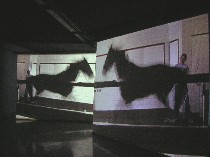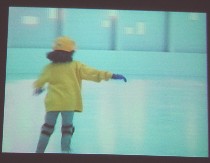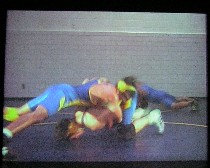 I finally made it over to Janet Biggs’ video installations at Moore College, but it served as a reminder that I’d been running around in circles and not getting too far.
I finally made it over to Janet Biggs’ video installations at Moore College, but it served as a reminder that I’d been running around in circles and not getting too far.
Take that poor horse — duplicated on two enormous screens — running on a treadmill. So much effort and no scenery as a reward. It rather reminds me of “The Mile,” a Burt Barr video I saw recently in Chelsea, with a runner who runs and runs and runs in scenery that is undifferentiated (see post here).
And behind the horse on a third screen, a group of water joggers go through their paces. The view is from below the water’s surface, and all you see are legs working in place. I have to get in here a note of appreciation for legs that belong to real, ordinary human beings. These are no Flo-Jo or Lance Armstrong legs or even Linda Evangelista legs. The piece is called “Ativan,” which is an anti-anxiety drug. I don’t know why.
 That same ordinariness of people in underwater circumstances is part of the fascination of “Apraxia,” a small, single-channel video of synchronized swimmers, in slow motion and upside down to boot. All I could think as I watched was, when are they ever going up (or rather down) for a breath of air? These women are exhibiting tremendous physical control to stay in one place under water. And they, too, are neither idealized or youthful. (Apraxia is a medical term indicating the inability to perform synchronized movements; I don’t know why this is the title of the video).
That same ordinariness of people in underwater circumstances is part of the fascination of “Apraxia,” a small, single-channel video of synchronized swimmers, in slow motion and upside down to boot. All I could think as I watched was, when are they ever going up (or rather down) for a breath of air? These women are exhibiting tremendous physical control to stay in one place under water. And they, too, are neither idealized or youthful. (Apraxia is a medical term indicating the inability to perform synchronized movements; I don’t know why this is the title of the video).
The slow-motion pieces bring to mind Muybridge motion studies.
 A young girl circles in slow motion on ice skates in “Bright Shiny Objects.” She seems to have a weak leg and a strong leg, but her body language is cheerful and relaxed. She too goes nowhere as does another horse, this one intercut with the girl, and running in circles. The camera also shows a figure walking across a frozen river as a voice repeats the first letters of the alphabet. The video ends at a hole through the ice–a nice segue to the underwater swimmers. I’m not sure what the bright shiny objects are. Maybe it’s the young girl, untested in life and adored even as she almost stumbles. Maybe it’s the windows in the wall behind her.
A young girl circles in slow motion on ice skates in “Bright Shiny Objects.” She seems to have a weak leg and a strong leg, but her body language is cheerful and relaxed. She too goes nowhere as does another horse, this one intercut with the girl, and running in circles. The camera also shows a figure walking across a frozen river as a voice repeats the first letters of the alphabet. The video ends at a hole through the ice–a nice segue to the underwater swimmers. I’m not sure what the bright shiny objects are. Maybe it’s the young girl, untested in life and adored even as she almost stumbles. Maybe it’s the windows in the wall behind her.
So far, with all of these pieces, I’m getting a sense of how we keep repeating the same mistakes over and over again, not getting anywhere, or how we work and work and don’t get anywhere.
Bodies are always a delight, and the slow motion is just slow enough to allow for digesting and analyzing the movements.
 That same technique applies in “Tegretol,” which by the way is the name of another nervous-system drug. I don’t know why the video has this name. Two large screens, sometimes synchronized with eachother and with the sound, sometimes not, show young men wrestling–not always the same pairs, but always great to look at. The slow motion of the holds and balance between the two bodies engaging for dominance is full of the pleasures of dance and athletics. Ultimately, though, nothing seems to change. It’s just the male rams locking horns on the lovely blue mats in the lovely blue, shiny unitards.
That same technique applies in “Tegretol,” which by the way is the name of another nervous-system drug. I don’t know why the video has this name. Two large screens, sometimes synchronized with eachother and with the sound, sometimes not, show young men wrestling–not always the same pairs, but always great to look at. The slow motion of the holds and balance between the two bodies engaging for dominance is full of the pleasures of dance and athletics. Ultimately, though, nothing seems to change. It’s just the male rams locking horns on the lovely blue mats in the lovely blue, shiny unitards.
For work that is physically big and requires a viewer to stand and pay attention for quite a while, the messages seem underwhelming–single gestures that don’t travel, rather like the horse on the treadmill.
Biggs, an alumna of Moore College, has had a number of solo exhibitions, including at RISD and the Kohler Arts Center, and has received a number of awards or grants, including from the National Endowment for the Arts, the Wexner Center Media Arts Program, and Panasonic Corporation.









